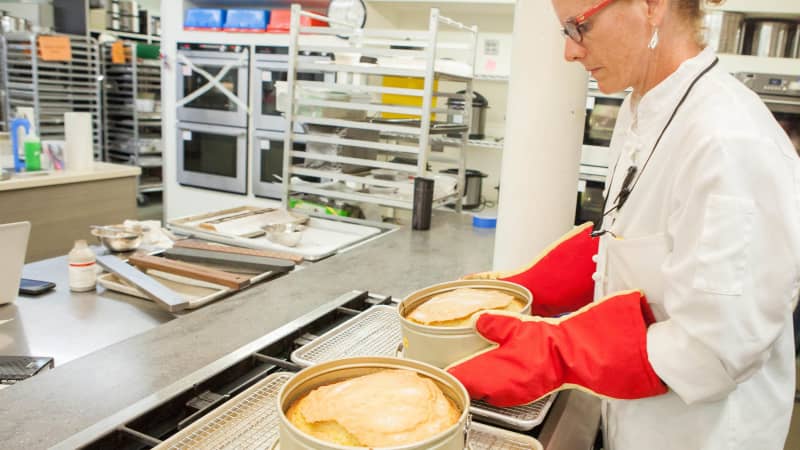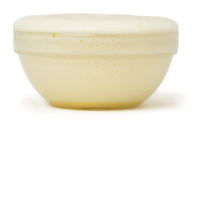My Goals
- Light, fine-textured crumb
- Subtle but noticeable olive oil flavor
- Simple yet attractive appearance
Published Apr. 4, 2017.

I wanted a cake that offered some intrigue but was at the same time simple, something I could enjoy with a cup of tea.
New England, where I've lived for most of my life, is not known for its vast and fruitful olive groves. Maybe that's why I only recently learned about olive oil cake, which is commonplace in most traditional olive-producing regions of the world.
That said, I've made plenty of cakes with neutral-flavored vegetable oil. Though most people associate cake with butter, oil is a good choice for simple snack cakes and quick breads because it provides moisture, tenderness, and richness without calling attention to itself. It also makes the mixing process simpler (more on this in a minute). But extra-virgin olive oil, the type I kept seeing called for in recipes for olive oil cake, can be noticeably grassy, peppery, and even a little bitter. That's welcome in a salad, but I was skeptical about how it would work in cake, so I made a few versions.
I happily discovered that the slightly savory notes of olive oil can, in fact, lend appealing complexity to a cake. But there's no definitive version. Some cakes had a lot of oil and a correspondingly assertive flavor and rich, dense crumb; others included only a modest amount of oil and were light and spongy, and the flavor was so faint that they might as well have been made with vegetable oil. Still others had so many additional ingredients—apples, spices, loads of citrus—that the oil's flavor was obscured.

And that’s fair enough. I suspect that such recipes originated not to showcase olive oil but because people wanted cake, they needed fat to make it, and the local olive oil was the fat they had on hand. But I have my choice of fats, so if I was going to be using extra-virgin olive oil in my cake, I wanted to be able to taste it, at least a bit. I didn’t want sponge-cake austerity or dense decadence but something between the two. I wanted a cake that offered some intrigue but was at the same time simple, something I could enjoy with a cup of tea.
One of the most attractive aspects of making a cake with oil rather than butter is the way it expedites the mixing process: There’s no waiting for butter to come to room temperature and then beating it with sugar before you even start to add the rest of the ingredients. With many oil-based cakes, you simply whisk the dry ingredients in one bowl, whisk the wet ingredients in another, and then combine the contents of the two bowls.

So that’s where I started. The dry ingredients were all-purpose flour, baking powder, and salt, and the wet ingredients were eggs, milk, the test kitchen’s favorite supermarket olive oil, plus the sugar. The batter was ready to go into the oven in 5 minutes flat, and the cake came out just 40 minutes later.
While there’s no need to splurge on a premium extra-virgin olive oil, spring for a good supermarket product such as our favorite from California Olive Ranch. A cheap supermarket EVOO won’t deliver enough character.
This first attempt was easy to make but not easy to love. The crumb was dry and coarse, and I could detect the olive oil flavor only if I thought about it really, really hard. As for the appearance, I was okay with simplicity, but this cake looked uninvitingly plain. What I really wanted was the kind of even, fine crumb that the best butter cakes have. The problem? That texture is largely due to their being made with butter.
In a butter cake, air is whipped into the butter before it’s mixed with the other ingredients. In the heat of the oven, the baking powder creates carbon dioxide, which inflates those bubbles a bit more. Those tiny bubbles are what make a butter cake fluffy and fine-textured.
But I wasn’t without options for producing a similar effect in my oil cake. Although most oil cakes use the “mix wet, mix dry, and combine” method, chiffon cake is an oil cake that’s mixed a bit differently. Its light and fluffy texture is achieved by whipping egg whites with some sugar to form a foam, which you then fold into the batter. Might that approach work for my olive oil cake?
I applied the chiffon method to my recipe and, at the same time, implemented a couple of ingredient adjustments: I increased the eggs from two to three for better lift and the olive oil from ½ cup to ¾ cup for more richness and moisture and a more pronounced flavor. The batter was promisingly airy and mousse-like. The cake rose impressively in the oven—but it fell when it cooled. And when I cut it open, there was a line of dense, collapsed cake in the middle.
It turned out that the batter was too airy to support all the fat; it essentially overextended itself. But I was happy with the more pronounced olive oil flavor, so I was reluctant to back down. Providing more support by switching to a tube pan, the vessel of choice for chiffon cakes, could help, but frankly I didn’t want my olive oil cake to be mistaken for chiffon. Instead, I’d adjust the mixing method.

If whipped egg whites were too airy, maybe whipping yolks, which aren’t as good at holding air, would be better. I did a quick test, but the cake came out dense and squat. Whipping whole eggs, I hoped, would be the solution. I put all three eggs, both whites and yolks, in the mixer bowl with the sugar and whipped the mixture for about 4 minutes, until it was pale and airy. I added the rest of the ingredients, including a tiny bit of lemon zest to accentuate the fruitiness of the olive oil. After pouring the batter into the cake pan, I sprinkled the top liberally with granulated sugar to lend some visual appeal and textural contrast.

JUST WHITES
Ultrafluffy egg whites made a cake that was too airy and collapsed.

JUST YOLKS
Unable to hold much air, egg yolks made a squat, dense cake.

WHOLE EGGS
Whipping whole eggs provided structure and just enough lift.
The whipped whole eggs did indeed provide just the right amount of lift, creating a crumb that was fine but not dense and light but not spongy. The sugar on top had coalesced into an attractively crackly crust that complemented the cake’s plush texture, and the lemon zest supported the olive oil flavor without overwhelming it.
And there’s one more advantage to my olive oil cake: Because it’s made with liquid fat instead of solid, it will keep longer than its butter-based counterparts. It can be stored at room temperature for up to three days—in the unlikely event that it doesn’t get eaten right away.
Unlike butter cakes, which start to taste dry just a day after baking, oil-based cakes and tea breads can taste moist for several days. This is an illusion, since over time the starches in both types of cakes retrograde, or stale and harden into a crystalline structure, and this structure traps water within the crystals. A cake made with butter, which is solid at room temperature, will seem drier. But oil, which is liquid at room temperature, acts to retard retrogradation, causing even a days-old cake to seem moist even though it’s actually not.
Light, fine-textured crumb
Whipping the whole eggs with sugar seeds the batter with millions of tiny air bubbles, producing a cake that is fine-crumbed and plush yet airy.
Subtle but noticeable olive oil flavor
We use ¾ cup of extra-virgin olive oil in our cake. Supplementing the fruitiness of the signature ingredient with just a bit of lemon zest highlights the olive oil flavor.
Simple yet attractive appearance
We bake the cake in a springform pan. A sprinkle of sugar on top of the batter forms a crackly crust during baking.

This is a members' feature.